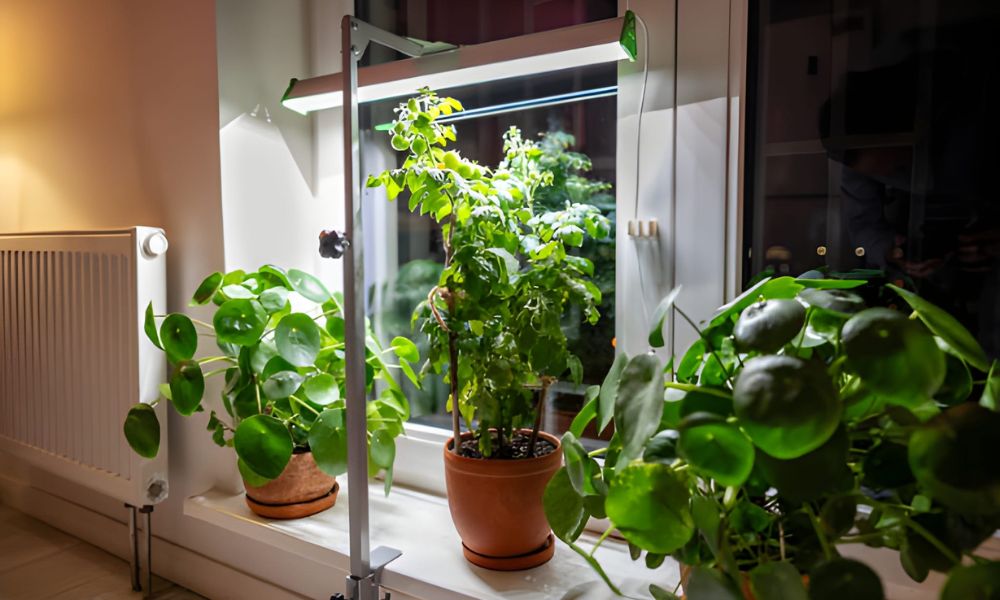I used to think a sunny window was all my plants needed. But when my basil started drooping, I knew something was wrong. That’s when I learned how to use grow lights for indoor plants. Since then, I’ve figured out how long to keep grow lights on, how to tell if a plant is getting enough light, and even how to measure grow light intensity with easy tools. In this guide, I’ll share what worked for me—so your plants can grow strong too.
What Are Grow Lights and Why Do Indoor Plants Need Them?
When I first grew herbs indoors, I thought a sunny window was enough. But my basil told a different story. It looked weak and stretched. That’s when I found out plants need more than just light—they need the right kind.
Grow lights help indoor plants grow strong and green. They copy sunlight. Plants use that light to make food through photosynthesis. It’s how they stay healthy and full of life. Without good light, they grow slow, turn pale, or drop leaves.
Not all lights work the same. Normal bulbs miss key parts of light plants need. But full-spectrum grow lights fix that. They give off all the colors plants need to grow indoors. I switched to LEDs, and my herbs exploded with life. My mint smelled fresh again. My parsley stood tall.
LED grow lights are the best pick for most homes. They’re bright, cool, and save power. Fluorescent lights are also good, especially for seedlings. But avoid old-style bulbs—they get hot and use more energy.
With grow lights, your plants get their own little sun—even in the darkest room.
Choosing the Right Grow Light for Your Space
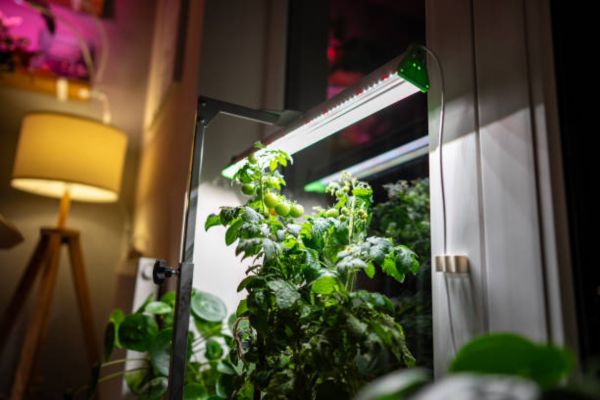
At first, I thought any bright bulb would help my plants. But after a few weeks, my succulents stretched out and my lettuce stopped growing. That’s when I learned something important—the type of grow light matters a lot.
LED grow lights are the best choice for most indoor plants. They stay cool, use less power, and last a long time. I switched to LEDs, and my herbs looked better in just days. They’re also safe for small spaces.
Fluorescent lights are another good option. They spread light well and work great for leafy plants. I used them for my spinach, and it grew fast. But they don’t last as long as LEDs.
Incandescent bulbs are not a good pick. They get too hot and waste energy. I used one early on, and my aloe plant started turning brown.
Now let’s talk about light color. Full-spectrum grow lights are best for all plant stages. They copy sunlight and help with root, leaf, and flower growth. I use them for herbs and lettuce.
Red and blue lights are more focused. Red helps with flowers. Blue supports strong leaves. My succulents love red-blue lights. They stay short, firm, and colorful.
If you want one light for all your plants, choose full-spectrum. But if you grow things like succulents or cactus, red-blue lights can be just right—and they cost less too.
Match Your Light to Your Plants
| Plant Type | Best Light Type | Light Hours per Day |
| Succulents | Red-Blue LED | 10–12 hours |
| Leafy Greens | Full-Spectrum or Fluoro | 14–16 hours |
| Flowering Herbs | Red + Full-Spectrum Mix | 12–14 hours |
| Seedlings | Fluorescent or Full-Spectrum | 14–16 hours |
Choosing the right grow light is like choosing food for your plants. The better the match, the better they grow. It took me a few tries, but now I know what each plant likes—and they’re thriving.
How to Set Up Grow Lights at Home
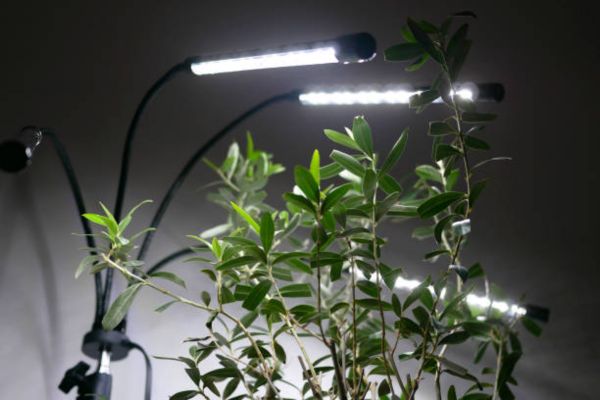
Setting up grow lights sounds tricky—but once you get the hang of it, it’s easy. When I first tried it, I hung my light too high. My tomato seedlings got tall and weak. They looked “leggy,” which meant they weren’t getting enough light. I moved the light closer, and they perked up in days.
The ideal distance for LED grow lights is 6 to 12 inches from your plant. Too close, and leaves can burn. Too far, and plants will stretch to reach the light. Keep LED grow lights 6–12 inches away from most houseplants. Adjust based on how strong the light is and how your plant reacts.
Here’s a simple rule: If your plant leans, stretches, or turns pale, it’s likely too far from the light. If the leaves curl or get dry edges, it might be too close. A little trial and error helps a lot.
Want to know the exact distance for different plants and light types? Check this detailed guide on how far grow lights should be from plants.
Best Placement Tips for Grow Lights
Place your grow lights above the plant, not to the side. Light from the top copies how the sun works. Use shelves, racks, or hanging hooks to get the right height. If you’re using a windowsill, add the light just above the plant to give it a boost.
Use a timer to keep things simple. I set mine to turn on in the morning and off after 12 hours. That way, I never forget.
Safety Tips and Heat Checks
Keep wires away from water. Always check that the light isn’t too hot. LEDs stay cool, but other lights can heat up fast. Give your plants some space to breathe—don’t crowd them too close to the bulbs.
Also, make sure the fixture is secure. I once had a clip-on light fall into a plant tray. No damage—but I learned to double-check my setup.
How Long to Keep Grow Lights On for Indoor Plants
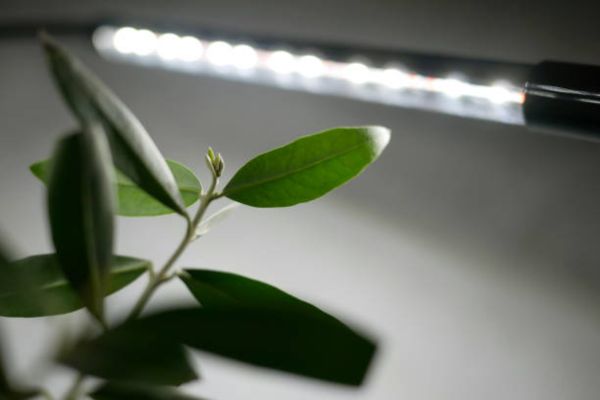
Timing is just as important as the light itself. At first, I left my grow light on all day and night. But my snake plant started looking stressed. That’s when I learned—most indoor plants need 12 to 16 hours of light daily. I now use a timer so I don’t forget to turn it off. It keeps things simple and my plants happy.
Different plants have different needs. Succulents prefer 10 to 12 hours of strong light. Too much can burn them. Leafy greens like spinach or lettuce love more—about 14 to 16 hours a day. They grow fast and full with longer light. Orchids need about 12 hours max. They’re a bit more delicate, so less is more.
The trick is to copy a natural day. If you keep the light on too long, plants don’t get time to rest. If it’s too short, they won’t grow well. That’s why timers are your best friend.
Recommended Light Hours by Plant Type
| Plant Type | Light Hours Needed |
| Succulents | 10–12 hours/day |
| Leafy Greens | 14–16 hours/day |
| Orchids | 10–12 hours/day |
| Herbs (Basil, etc.) | 12–14 hours/day |
| Seedlings | 14–16 hours/day |
Setting the right time for your grow lights can boost growth, save power, and keep your plants stress-free. For me, a simple plug-in timer made all the difference.
How to Know If Your Plant Is Getting Enough Light
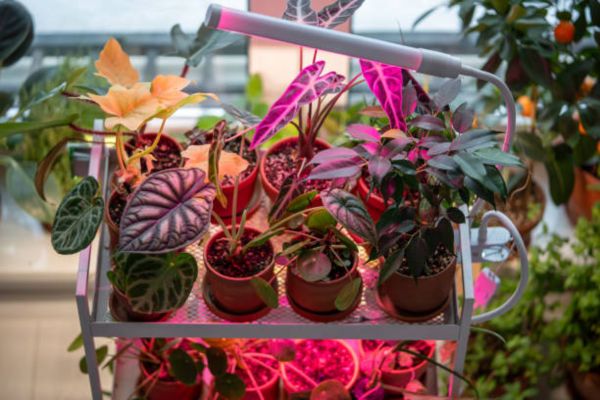
Your plant will tell you if it’s not getting the right light—you just have to know what to look for. When my basil started turning pale and slow, I thought it needed more water. But the real issue? Not enough light. I adjusted the grow light hours, and within days, the leaves darkened and looked healthy again.
Stretching, yellowing, or drooping leaves are common signs of too little light. The plant grows tall and thin, trying to reach for light. On the flip side, burned or crispy leaf edges can mean it’s getting too much.
Using Apps or Tools to Monitor Plant Health
You don’t need fancy gear to keep track. I use a free lux meter app on my phone to check light levels. It’s quick and works well for small spaces. Some apps even send reminders to adjust your light time.
You can also do a simple test with your hand. Place it between the light and the plant. If it casts a sharp shadow, the light is strong. If the shadow is faint, the light may be too weak.
How to Measure Grow Light Intensity (Without Expensive Gear)
At first, I had no idea how much light my plants were getting. I just guessed—and sometimes guessed wrong. Then I found a simple fix. I started using a free lux meter app on my phone. It was easy to use and worked surprisingly well for basic indoor setups.
You can measure grow light intensity using a lux meter, PAR meter, or even a hand shadow test. Lux and PAR meters are more accurate, but if you don’t have one, your phone or even your hand can do the job.
Tools You Can Use: PAR Meter, Lux Meter, or Smartphone Apps
PAR meters measure the light plants use for growth. They’re great—but pricey. For home use, a lux meter is a solid option. It shows how bright the light is in a specific spot.
Many free apps turn your phone into a basic lux meter. That’s what I use. It helps me check light levels around my shelves. It’s not perfect, but good enough to spot weak spots or too much glare.
DIY Trick: Hand Shadow Test for Light Strength
Here’s a quick trick I love. Hold your hand above the plant. If it makes a sharp shadow, the light is strong. If the shadow is soft or missing, the light is weak.
This method won’t give you numbers, but it’s great for fast checks. I still use it when I move plants to a new spot. It’s that simple.
Special Note – How Many Hours of Grow Light for Succulents?
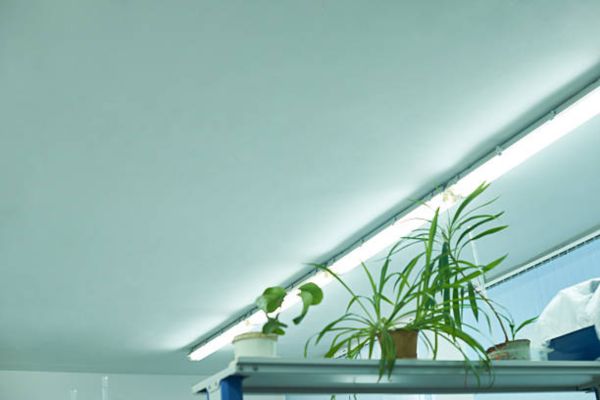
Succulents are tough—but indoors, they can be tricky. These desert plants love bright light but not too much heat. That’s why the kind of light and timing really matter.
Succulents need 10 to 12 hours of direct, bright grow light every day to stay compact and healthy. If they don’t get enough, they stretch and grow tall. That’s called “etiolation,” and it makes them look thin and weak. I learned this the hard way—I fried a few jade plants before learning they prefer intensity over duration.
Keep the light close, but not too close. The ideal distance is about 6 to 10 inches. Closer than that, and leaves may burn. Farther away, and your plant may stretch toward the light.
If you notice soft, pale leaves or your succulent leaning hard to one side, it’s a sign the light needs adjusting. A timer helps too—I set mine for 11 hours and check in once a week to see how things look.
FAQs
Can I use a regular lamp or bulb as a grow light?
Only if it’s full-spectrum or labeled for plant growth. Most normal bulbs don’t have the right light mix and can leave your plant struggling.
What color light is best for indoor plants?
Full-spectrum light is the best choice for most plants. But red and blue lights also work well—red helps flowering, blue boosts leaf growth.
How long until I see results with grow lights?
Usually in 1 to 2 weeks, you’ll notice greener leaves and stronger growth. Some plants take longer, but you’ll see small signs early on if things are working.
Final Thoughts
When I started, I made mistakes. My plants stretched. Some even turned yellow. But once I got the light right, they began to thrive. The right setup and timing lead to healthy, happy plants.
Grow lights changed my indoor garden. My basil is now full and green. My succulents stay short and firm. Even in winter, I can grow fresh herbs right in my kitchen.
Don’t stress if it’s not perfect. Every plant is a little different. Some need more light. Others need less. The key is to try, watch, and adjust.
Start simple. Use a timer. Check your plant once a day. You’ll learn fast—and your plants will show you what works.

